Your Office Document is at Risk – XLL, A New Attack Vector
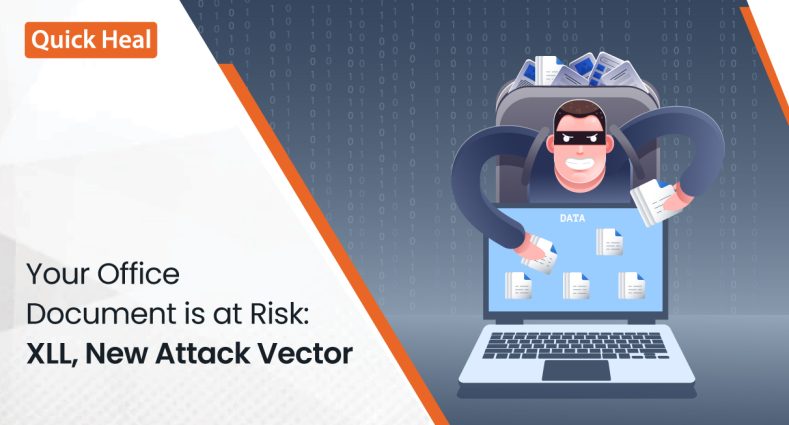
Microsoft Office documents are used worldwide by both corporates and home-users alike. It’s different office versions, whether licensed or unlicensed offers users an easy way to create and modify files. However, this software is also susceptible to cyberattacks.
Cybercriminals often take advantage of its vulnerability and use VBA (Visual Basic Application) macros as entry points to gain access to targeted systems and devices.
Over the years, VBA macros has been a domineering threat for Office documents with its ability to spread malware. And, this is why Microsoft has finally decided to block VBA macros for files that have ‘mark of the web’ (MOTW) tag. With this change, whenever users open a file downloaded from internet, such as email attachments which have macros, the following message will be displayed:

Fig-1. Security Risk Warning
As a result, attackers are now forced to think of alternative ways to reach their victims. And, here’s where Microsoft Add-ins come into the picture.
What is Microsoft add-ins?
An add-in is a software program that expands the capabilities of main programs. It is a term commonly used by Microsoft and other platforms which have additional functions that can be added to primary programs. Office add-ins are DLL files which have different extensions depending on the application. Microsoft Excel and Word have add-ins with the file extensions, ‘.xll’ and ‘.wll’ respectively.
For Word, the ‘.wll’ add-in needs to be placed in a specific location, specified by the registry value HKCU\Software\Microsoft\Office\16.0\Word\Security\Trusted Locations, depending on the Office version. This will ensure that ‘.wll’ add-in gets executed by word application.
For Excel add-ins, whenever ‘.xll’ file gets loaded, it will be opened by an excel application.
Malicious XLL files
Many threat actors have started using XLL files as the initial vector. These files are mainly shared as an email attachment. It is associated with an icon similar to other excel supported file making it hard for end users to distinguish between the original excel file and an add-in file.
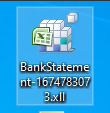
Fig-2. Malicious DLL with .XLL extension
Upon opening such files, excel will display a warning about the malicious code in it.
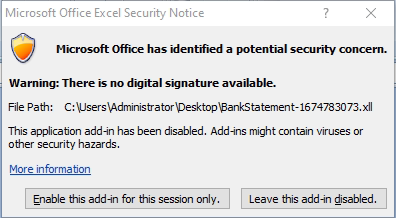
Fig-3. MS office warning for Add-in
It is possible for a “.dll” (dynamic-link library) file to be renamed as a “.xll” (Excel add-in) file and used for malicious purposes. The difference between a regular DLL and an XLL file is that XLLs can have certain exported functions which will be called by the Excel Add-In manager if triggered by the Excel application. When XLL file is launched by Excel, it will invoke the export functions based on the defined XLL interface like xlAutoOpen and xlAutoClose similar to the methods Auto_Open and Auto_Close in VBA macros. These functions can be used to load malicious code and download malware payload.
Technical Analysis:
It begins with a file named “BankStatement-1674745402.xll”, which is a 64 bit DLL file. This file contains one export function in it with a name “xlAutoOpen” as shown in fig 4.

Fig-4. DLL Export Function
We have executed this DLL file explicitly using “rundll32.exe” with the parameters,
“C:\Windows\SysWOW64\rundll32.exe C:\Users\user\Desktop\9009859256\BankStatement-1674745402.xll, xlAutoOpen”.
In fig 5, we can see process execution flow.
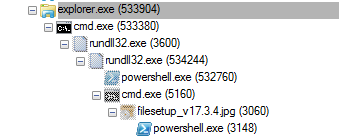
Fig-5. Process Flow of Execution
The export function has a code (shown in fig 6) that uses the strcat function to generate different strings that are having link and commands for execution. The below function creates a link “http[:]//160[.]119[.]253[.]36/filesetup_v17.3.4.zip” and it tries to connect to this link to download the zip file and saved as a “mypictures.zip”.
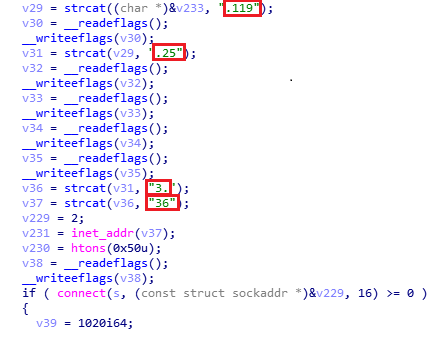
Fig-6. Code for generation of Link and connection
After this, PowerShell is used to unzip this zip file into the %Temp% folder with the below-mentioned command,
“powershell.exe Expand-Archive –Path “C:\Users\user\AppData\Local\Temp\mypictures.zip” -DestinationPath “C:\Users\user\AppData\Local\Temp\””
After unzipping we get “filesetup_v17.3.4” named folder in the %Temp% folder which has the “Resources” folder and “filesetup_v17.3.4.jpg” file inside.
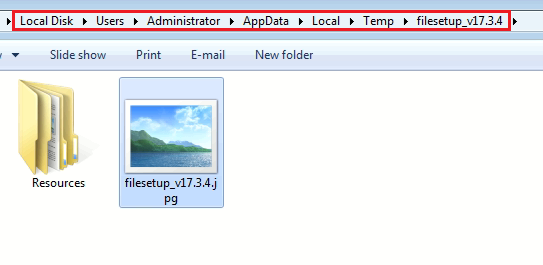
Fig-7. filesetup_v17.3.4 folder into Temp
Resources folder has multiple XML files containing dummy data. Attackers purposely put that data to make the analysis gruelling. The “filesetup_v17.3.4.jpg” is not an image file format file. It is nothing but a 32-bit PE File written in .NET language and it looks like an Inno Setup Module installer.
An Inno Setup is a free and popular installer framework used to create installers for Windows applications. It provides a scripting language that allows developers to customize the installation process, including the creation of shortcuts, registry entries, and other system configuration.
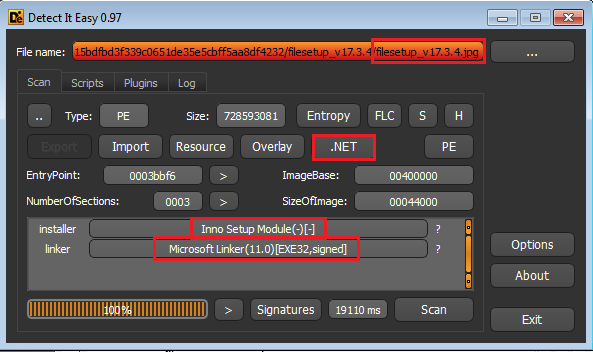
Fig-8. “filesetup_v17.3.4.jpg” file info in Die tool
This .NET file has 213 methods in it (shown in fig 9) which are highly obfuscated. We can de-obfuscate using de4dot obfuscators. To avoid reversing a .NET application, the author has implemented multiple methods to make it more difficult for any researcher to understand the code and logic of the application.
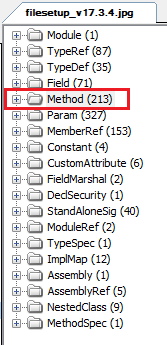
Fig-9. “.NET Methods Count”
This “filesetup_v17.3.4.jpg” file executed using below mentioned command,
“cmd.exe /c start C:\Users\user\AppData\Local\Temp\filesetup_v17.3.4\filesetup_v17.3.4.jpg”
This file uses a few anti-debugging techniques at the start of the execution which are mentioned as below,
1. OllyDbg is a popular debugger tool that can be used to analyze and modify running programs, including .NET applications. One technique for detecting and preventing debugging using OllyDbg involves checking for the presence of a specific string that is associated with the debugger.

Fig-10. OLLDBG Tool Check
2. Debugger registry check which is used to determine if a debugger is attached to the process and take appropriate action if one is found.

Fig-11. Debugger registry check
3. IsDebuggerPresent function is used to detect if a debugger is attached to the process or not.
4. CheckRemoteDebuggerPresent function is used to detect if a debugger is attached to the current process or a remote process or not.
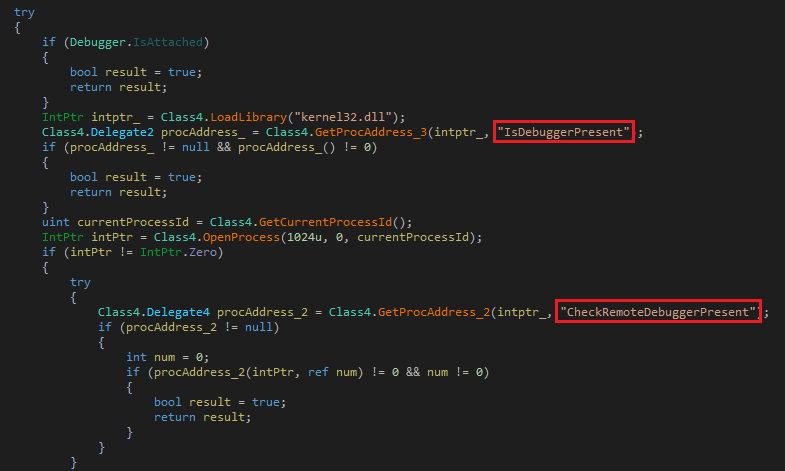
Fig-12. IsDebuggerPresent and CheckRemoteDebuggerPresent Functions
Racoon Stealer V2 is a type of malware that is designed to steal sensitive information from infected systems. It is capable of stealing various types of files, including .ttf and .xml files, and storing them on the infected system. However, if the CNC (command and control) server is not operational, the malware may be unable to send the stolen information to the server for exfiltration.
In this scenario, the stolen .ttf and .xml files may remain on the infected system until the CNC server becomes available. This can potentially expose sensitive information to the attacker, as they may still be able to access the stolen files on the compromised system.
Quick Heal Protection:
Quick heal security labs has been actively hunting for these types of files to ensure that all Quick Heal customers are protected with the following detections.
- Downldr.XllfmAgent.S29349494
- Downldr.XllDanot.S29357788
- Trojan.GenericRl.S24740760
- Trojan.RacoonStealerCiR
Conclusion:
In conclusion, Microsoft Add-Ins can present a potential threat vector for malware like Raccoon Stealer V2. These types of malware are designed to steal sensitive information from infected systems and use Microsoft Add-Ins as a means of delivering the malware to target systems. To mitigate this risk, organizations should implement best practices for endpoint security, such as keeping software up to date, implementing strong antivirus and anti-malware solutions, enabling firewalls and other network security measures, as well as educating users on the steps for identifying and avoiding social engineering attacks. By taking these measures, organizations can significantly reduce the risk of malware attacks and data theft through Microsoft Add-Ins and other potential attack vectors.
IOCs:
IP:
160.119.253.242
160.119.253.36
45.93.201.114
URL:
http[:]//160[.]119[.]253[.]36/filesetup_v17.3.4.zip
Malicious DLL File:
ab06eca36c9e011a149ea1625b8ad3629907b2a418ce10fe039870a3d9928bb0
9a652f77b9fba07d04e4021d3f533791bdedf4284fbbc007b4c55fea94a46635
6f74060f131c9034f55349cdeb2b5ebbd73582e6ac9da11c9310892bfdfeba36
5dfa56596b133d080b770e11783b1763da445dc2fef57fe060c87e7b73012308
2d9e90155343ba8f8f8e16c80b1dc62227f607c2ba277491c6f8f384bf5e0499
16522212c1b951ffab57e8f8fa288295cca5d9600e83b74551601246841cae91
0ec2bb5aad17efc7e1e1d8371b04684957684fec8e73df62bd41320bbf517b13
4da00e7d529be457c914b085d66f012c070bf6e3f85675303aa41a7689c08c75
Malicious ZIP File:
59d2403b99c95a057e43dd25e3d58b66331d130b52c19d2919e7966023ede5f6
Subject Matter Expert:
Anjali Raut, Akshay Gaikwad


No Comments, Be The First!